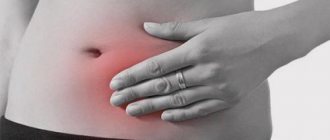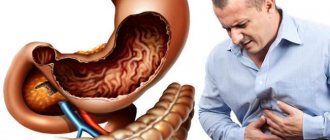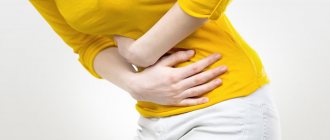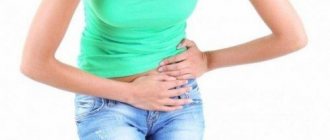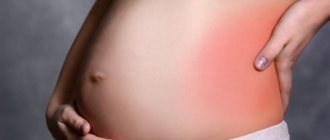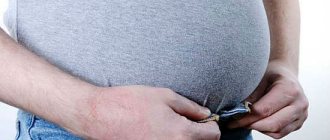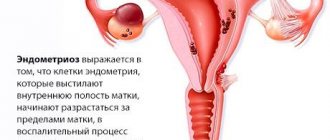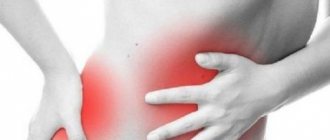Pain in the groin on the left indicates pathologies of the internal organs. The disease may be associated with disorders of the gastrointestinal tract, pelvic organs, and even the musculoskeletal system. Unpleasant sensations are accompanied by other symptoms. These include nausea, vomiting, fever, loss of strength, disorders of the cardiovascular system and others.
There are many causes for pain in the left hip and groove. Among them are heredity, inflammatory processes, internal injuries and bleeding, pregnancy and others. To diagnose the disease even at an early stage, seek qualified medical help at the KDS Clinic. Examinations are carried out on modern equipment using innovative technologies. To be healthy and not develop a disease, undergo a comprehensive diagnosis of your body as soon as possible.
What organs are located in the lower left corner of the abdomen?
Organs of different systems are located on the left lower abdomen. Digestion includes: the small intestine - loops of the jejunum, part of the descending colon and the sigmoid - large intestine. To the organs of the genitourinary system: the left half of the uterus, the left appendage with the ovary and fallopian tube in women, the ureter and part of the bladder.
We must not forget that pain on the left side of the lower abdomen can cause disturbances in the bone skeleton of the pelvis, hip joint, lymph nodes, nerve bundles and vessels, irradiation downward in diseases of the spleen and left kidney.
How does pain occur?
The causes of pain syndrome according to the mechanism of formation are different in parenchymal and hollow organs. Dense organs (spleen, uterus, kidney) are covered with a protective capsule. It contains pain endings of nerves that react to any damage.
In hollow organs (intestines, ureter), pain occurs when the muscle wall is stretched if the damage reaches the level of the submucosal and muscular layer. The mucous membrane itself does not have the ability to cause pain, since it is not equipped with special receptors.
Pathological processes leading to pain in the lower abdomen can be:
- inflammation;
- degeneration of an organ or wall due to impaired metabolism at the cellular level;
- local circulatory obstruction;
- functional or organic malfunctions in the functioning of internal organs.
Necrosis (death) of the intestine - extreme ischemia
Physiologists distinguish 3 stages in the development of pain:
- I - aching sensations appear in the lesion, they are not defined by the patient as painful;
- II - formation of referred pain, possible loss of connection with the true cause;
- III - expansion and deepening of pathological disorders, strengthening of the pain impulse from the site of the lesion.
We will consider options for pain in the left side and lower abdomen, depending on the possible pathology of the organs.
Prevention measures
The best preventive measure is timely contact with a specialist. It is much easier to treat the disease at an early stage. This will minimize the likelihood of complications. To prevent the re-development of intestinal diseases, you will need to follow a diet.
Usually it is enough to adhere to proper nutrition standards. Prevention of cystitis and diseases of the urinary system usually consists of maintaining good hygiene. Additionally, it is recommended to visit a gynecologist at least once every six months. Most gynecological diseases at an early stage are asymptomatic. Noticing them on your own is quite problematic.
Pregnancy should be completely under the supervision of a doctor. You need to register in a timely manner. A woman must undergo all preventive examinations. You should not refuse hospitalization, even if the doctor recommends it for preventive purposes or in case of a minor threat. In any case, it is better not to relieve pain, but to prevent it. To do this, you need to follow simple rules of hygiene, strengthen your immune system, engage in moderate physical activity, especially during sedentary work, adhere to a healthy lifestyle and monitor your diet.
What types of left side pain should you consider?
The nature of the pain serves as a guide to the assumption of the location and type of pathology.
Aching dull pain
Often worries women with a unilateral gynecological problem. Dull pain above the pubis and on the left is possible with cycle disorders, sex, inflammation and endometriosis. Inflammation is indicated by a combination with elevated temperature and weakness.
Nagging pain
In intensity it is significantly inferior to other types, but it exhausts a person with its constancy. In men, it occurs with inflammation of the scrotum, strangulated inguinal hernia, orchitis. Initially, a malignant tumor manifests itself in a similar way.
Sharp pain in the side
The sharp nature of the pain accompanies intestinal spasm, distension with gases, acute expansion of the bladder and pelvis of the left kidney during urinary retention, rupture of the ovary in women, and the passage of stones through the ureter.
Stitching pain
Colic is an acute spasm caused by contraction of the intestines or ureter. Typically subsides after defecation and urination. A type of pain is shooting pain. It is characteristic of inflammation in the lumbar region and joints. Stitching pain can precede the rupture of an ovarian cyst.
Pyelonephritis, cystitis
The causes of such ailments are associated with infection in the urinary tract. With an inflammatory process in the bladder, acute pain develops in the groin area, which becomes more acute when urination occurs. Sometimes it is very difficult for a woman to pee, since this process cuts a lot.
Both pyelonephritis and cystitis are treated with antibiotics, as well as nitrofuran drugs. During an ectopic pregnancy, the fertilized egg is implanted outside the uterine cavity (this can be the ovary, abdominal cavity, fallopian tube). In this condition, a woman with a tubal abortion experiences periodic pain in the groin area. Paroxysmal pain, as before or during menstruation.
What pain characterizes diseases of the small intestine?
Diseases of the small intestine affect all sections, causing severe pain with a cutting tint, cramping type. Accompanied by impaired absorption capacity, frequent loose stools, loss of fluid and electrolytes, vitamins, and protein.
Enteritis
A small segment of jejunal loops lies on the left side of the abdomen. With infectious enteritis and gastroenteritis, inflammation is accompanied by patient complaints that “the lower abdomen hurts on the left.”
Symptoms of the disease cannot be separated from signs of gastritis (inflammation of the stomach). The temperature rises, nausea appears, vomiting is possible, pain migrates from the epigastrium to the center of the abdomen. There is a lot of mucus in the stool, undigested food particles, and possibly blood.
Malabsorption syndrome
The essence of pathological disorders comes down to the inability of the mucous membrane to absorb certain foods (for example, fruits, milk). The main symptom is frequent loose stools with the release of fat.
The intestines are bursting with gases, so the pain in the left lower abdomen and side is cramping in nature, inconsistent, and can cause attacks. After bowel movements or taking medications with antispasmodic effects, the pain subsides. At the same time, patients complain of rumbling, bloating, and a taste in the mouth.
Celiac disease
The disease is detected in children during the infant period when switching to nutritional formulas or introducing nutritional supplements. It turns out that the child is intolerant to gluten (plant protein from cereals). Clinically manifested by abdominal pain, diarrhea, weight loss, and the development of rickets.
Both diseases are caused by unfavorable heredity. Malabsorption syndrome also accompanies functional disorders in other serious diseases.
Pathology of the left part of the large intestine
The abdomen hurts on the lower left side if the descending or sigmoid colon is involved.
Irritable bowel syndrome
The cause of the disease remains unclear. It is associated with stress and hormonal disorders. Middle-aged women are more often affected. It has been established that exacerbations develop against the background of menstruation.
The disease is chronic, manifested by pain in the left abdomen, bloating, and stool disturbances (constipation alternating with diarrhea). An important feature is the absence of any morphological abnormalities in the intestines. Acute pain in the left side is provoked by anxiety, eating fried or smoked meat dishes.
Nonspecific ulcerative colitis
The disease is caused by autoimmune disorders or is inherited.
Pathological changes begin from the rectum and spread from below to the upper intestines
Based on the principle of localization, nonspecific inflammation is distinguished:
- only the rectum (proctitis);
- sigmoid and straight (proctosigmoiditis);
- left side (left-sided colitis);
- with damage to the entire colon (total colitis).
In 18–30% of patients, the process reaches the ileum and appendix (ileocolitis). The intestinal walls have morphological changes; histologically they are located only in the mucous and submucosal layer. Ulcers are most often found in the sigmoid and rectum. There is a tendency to degenerate into a malignant neoplasm.
Clinically, during an exacerbation, patients experience sharp pain in the lower abdomen on the left, of a paroxysmal nature. Associated symptoms are: joint pain, fever, diarrhea with blood and pus. Antimicrobial agents, antihistamines, and corticosteroids are used in treatment.
Diverticulosis
Diverticula are saccular formations from the intestinal wall. They protrude outward and interfere with peristaltic waves. More often observed in old age. In the presence of dense fecal stones and inflammation, the patient experiences throbbing pain in the left side of the abdomen. At the same time, constipation and black feces due to bleeding are a concern. The disease is treated only surgically.
Colon polyps
Benign formations on the mucous membrane (polyps) are a mechanical obstacle and disrupt the process of water absorption. Identified by constipation and signs of dehydration. The pain in the lower abdomen on the left has a pulling character.
Despite their benign nature, polyps can cause intestinal obstruction
Atonic constipation
Atony of the large intestine can be caused by chronic inflammatory processes, polyps, and neurological problems. The main violation is the lack of proper regulation of peristalsis, loss of the ability to contract and transport contents.
Often observed in old age. The main symptom is prolonged constipation, bloating, and dull, bursting pain. Fermentation processes cause increased gas formation, and the accumulation of gases in the descending colon is manifested by constant aching pain in the left side.
Malignant neoplasms
Colorectal cancer is a malignant neoplasm of epithelial cells located in the colon and rectum. In the Russian Federation, it ranks third in frequency among malignant tumors in men and fourth in women.
The disease is asymptomatic for a long time. Signs begin with increased fatigue, loss of appetite, nausea, bloating, sudden vomiting, taste in the mouth, belching, and a feeling of heaviness in the upper abdomen.
At first it hurts only on the left, in the place where the tumor is localized. Then the intensity increases and the pain spreads throughout the abdomen. With a hardware examination of the intestines, it becomes clear why the left side and the area in the lower abdomen hurt.
Pain syndrome with tumors of the left half of the colon is more pronounced
Flatulence
This is a condition in which the normal balance of intestinal microflora is disrupted, resulting in increased gas formation. Normally, the maximum production should be no more than 0.5 liters of gases. If their volume increases to 2 liters, a pain syndrome forms below, on the left.
The condition often develops due to physiological changes:
- prolonged constipation;
- eating too much food;
- fermentation of the food bolus.
Less commonly, the condition is formed due to pathologies of the digestive tract, which disrupt the process of production and elimination of gases. Therefore, the following clinical signs are formed:
- bloating of the abdomen, in which the wall becomes hard and elastic;
- belching, heartburn, hiccups, nausea;
- removal of gases that have a putrid odor;
- frequent spasms;
- impaired fecal formation with the development of constipation;
- deterioration of health, malaise, heaviness in the stomach.
The following treatment methods have been identified:
- eliminating fermentation in the intestines, which leads to increased production of gases, use Mezim, Digestin, Festal, they normalize the digestion process;
- a diet with a reduced amount of foods that cause rotting, fermentation, and increased gas formation.
It is necessary to exclude cabbage, legumes, peas, and fresh baked goods from the diet.
Other causes of pain
A relatively rare disease is Hirschsprung's disease, which is transmitted hereditarily mainly to boys.
Abdominal pain and diarrhea
The essence of the pathology is the presence in the large intestine of zones without innervation. Therefore, the main disorder is the lack of peristalsis in the affected areas, the accumulation of feces in them, and severe constipation.
The main complaints of patients: constipation, constant bloating, nagging pain in the left side of the abdomen. The disease is treated only surgically, removing the area unsuitable for digestion.
Crohn's disease is the formation of inflammatory nodules (granulomas) in the intestines and other parts of the digestive tract. The reason is unclear. With inflammation in the descending colon, abdominal pain is localized to the lower left. Patients experience constant fatigue, loss of appetite, diarrhea, nausea and vomiting.
The disease is diagnosed only on the basis of a biopsy of material from the site of inflammation.
Diagnostics
Due to the variety of causes of tingling in the side, a comprehensive examination is recommended for the patient. The primary examination is carried out by a gastroenterologist; if necessary, a consultation with a hepatologist, gynecologist, or surgeon is scheduled. Physical data are often uninformative, so the diagnostic search includes a number of instrumental and laboratory studies:
- Ultrasound of the abdominal organs.
The screening diagnostic method is effective for identifying typical pathologies: signs of inflammation and stone formation in the gallbladder, intestinal diseases, enlarged liver or spleen. For probable gynecological reasons, women undergo targeted transvaginal ultrasound. - Image radiography of the OBP.
The study is used to assess the condition of the abdominal organs, detect gallstones, indirect signs of inflammatory or tumor processes in the intestines. To verify the diagnosis, the examination is supplemented with radiography with oral contrast and irrigography. - Endoscopic methods.
If there are difficulties in diagnosis, sigmoidoscopy or colonoscopy is recommended. Endoscopy visualizes the condition of the colon mucosa and allows you to take a biopsy of pathologically changed areas. In case of damage to the organs of the hepatobiliary zone, ERCP is an informative method for examining the bile and pancreatic ducts. - Additional research.
To assess the functional activity of the biliary tract, duodenal intubation is performed. If chronic liver disease is suspected, elastography and scintigraphy are indicated. To clarify the diagnosis in doubtful cases, they resort to CT of the abdominal cavity and positron emission tomography. - Laboratory methods.
The standard diagnostic complex includes a hemogram, a clinical urine test, and a stool test for helminth eggs. For the differential diagnosis of biliary, pancreatic and intestinal pathologies, a coprogram is informative. To study the functioning of the hepatobiliary system, liver tests are performed.
Ultrasound of the hepatobiliary zone
Characteristics of pain in diseases of the urinary organs
Urinary diseases occur in cases of pathology of the kidneys, bladder, and ureter. The localization we are studying includes local pain in the ureter caused by its stretching and radiating pain from the left kidney.
Pyelonephritis
Inflammation of internal structures (pelvis, calyces) caused by infection. It begins suddenly with high fever, vomiting, chills, pain in the lower back on the left, radiating to the left side of the abdomen. Impaired urination, pain, and urinary retention occur. Pulsating pain is an unfavorable sign indicating the formation of an abscess in the kidney.
In the chronic course, exacerbations are milder, but with the same symptoms. As a result, scars appear in place of the inflamed tissue, the kidney becomes deformed and loses function. Kidney failure occurs when the second healthy kidney stops working hard to compensate for the diseased organ. The disease is treated by urologists with antibacterial agents, diuretics, and, if necessary, by opening the suppuration or resection of part of the kidney.
Urolithiasis disease
Often accompanied by inflammation of the urinary tract and metabolic disorders. It is caused by the loss of crystalline sediment in the urine, its settling in the pelvis and gluing into stones. The most common compositions are phosphates, oxalates, and urates.
The stone causes a disruption in the process of urine outflow, so stagnation and distension form in the higher-lying sections. The movement of a stone along the ureter explains why the lower abdomen hurts. Clinically, after intense shaking or running, the patient experiences an attack of renal colic.
The pain is very intense in nature, cutting. Localized in the lower back or to the left of the navel. Acute urinary retention occurs. The duration of the attack is up to several hours. For emergency care, painkillers and antispasmodics are administered. Frequent recurrence of attacks is an indication for surgical removal of the stone.
Painful manifestations in gynecological pathology
Since the uterus is an unpaired organ, pain during its inflammation and endometriosis spreads from the suprapubic zone to both the left and the right; it is possible to single out only the left-sided localization for diseases of the left appendage.
Adnexit
Inflammation of the ovary is provoked by hypothermia and heavy physical work. The cause is infection. The chronic disease is accompanied by constant aching pain in the left lower abdomen and fever. It intensifies during sexual intercourse and during menstruation. A long process leads to the formation of adhesions.
Cyst torsion
A voluminous hollow formation from the left ovary may have a narrow base (pedicle). If a cyst is present, women note that before the acute attack, the pain in the left side was “tolerable.” Torsion causes intense pain on the left in the iliac region, in the side. During an attack, the cyst may rupture with the appearance of local peritoneal symptoms. Treatment in gynecology is only surgical.
At the initial stage, the left ovarian cyst is located inside the organ and does not cause symptoms, except for disruption of the menstrual schedule
Ectopic pregnancy
The disease manifests itself as an attack of gradually increasing pain in the left side of the abdomen, below, nausea and vomiting. Preceded by a delay in menstruation. Lack of measures leads to rupture of the left tube, peritonitis and multiple adhesions. A woman becomes infertile because the egg does not travel to the uterus.
Allen-Masters syndrome
The disease manifests itself in women in the postpartum period. It consists of rupture of the uterine ligaments during difficult childbirth. Often complicates abortion. The patient experiences cramping pain, which is localized in the lower abdomen, sometimes only on the left or in the anal area. Intensifies with straining.
The pain is burning in nature and radiates to the left half of the abdomen. During a digital examination, the gynecologist reveals excessive mobility of the cervix and pain when pressing on the abdominal wall.
Diverticulitis
With pathology, nodes form on the intestinal wall, which lead to protrusion. They are called diverticula. Pathology develops due to prolonged accumulation of stagnant food. The condition usually develops more often in women.
The pathology has multiple etiologies. Develops under the following conditions of the body:
- a diet with a decrease in the amount of fiber, as a result of which diverticula can grow for many years (pathology intensifies in people who often consume processed foods, baked goods, excluding plant foods);
- chronic dysbiosis caused by decreased immune function;
- helminthic infestation, causing disruption of the structure of the intestinal walls, irritation, and the formation of a prolonged inflammatory process;
- the spread of bacteria and fungi that cause inflammation.
People with a family history of diverticulitis are susceptible to diverticulitis. That is, their close relatives must suffer from chronic inflammatory diseases of the digestive tract, including diverticulitis.
With diverticulitis, a dull and aching pain develops. Additionally, the following negative symptoms are characteristic:
- constant, monotonous pain, spreading only to one area of the abdomen;
- periodic alternation of diarrhea and constipation due to impaired stool formation;
- discharge of blood into stool;
- low-grade fever that develops as a result of inflammation of the mucous membrane;
- increased discomfort, especially during defecation or pressing on the abdomen;
- nausea, vomiting, abdominal discomfort, decreased appetite.
A number of techniques are used to treat diverticulitis:
- antibacterial drugs that affect only the digestive tract - Cefoxitin, Timentin;
- anti-inflammatory drugs that eliminate swelling - Salofalk;
- antispasmodics - Drotaverine, No-shpa;
- painkiller based on NSAIDs - Nise, Nimesulide.
Other drugs are symptomatic treatments. That is, as negative signs arise, medications are supplemented.
If discomfort occurs in the stomach or lower abdomen, the presence of a digestive pathology is suspected. To identify its location, a general examination is not enough. It is important to conduct diagnostic tests using laboratory and instrumental tests. Without this, it is impossible to identify the exact localization of the damaging process.
